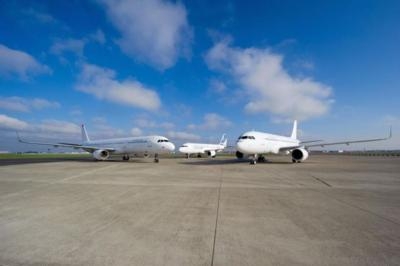Tue, Dec 04, 2012
Airbus Expects Certification Of Wingtip Devices On Other Models To Follow
EASA has certified the "Sharklet" wingtip devices on airbus A320s with CFM engines. This certification, received from the European airworthiness authorities (EASA), is expected to be followed "very soon" by FAA certification, Airbus said.

“The certification of Airbus’ Sharklets is a milestone which paves the way for airlines to benefit from savings in fuel of around four percent," said Tom Williams, Executive Vice President of Programs at Airbus. "That’s better than we’d anticipated. The annual greenhouse gas emission reduction per aircraft equipped with Sharklets will be approximately 1,000 tonnes of CO2 – that’s equivalent to taking 200 cars off the roads.”
For the flight test campaign, A320 Family aircraft with both CFM56 and V2500 engines have recently taken to the skies with Sharklets. When complete, this flight testing will represent approximately 600 flight-hours spread over 9-10 months. Certification of the remaining aircraft/engine variants with Sharklets will therefore follow in the coming months. By the end of 2012, Air Asia will become the first airline to take delivery of Sharklet-equipped A320s.
Due to what Airbus says is very strong customer demand for Sharklets, all Airbus’ single-aisle final assembly lines (FALs) will be engaged in building A320 Family aircraft with the devices. These FALs are located in Toulouse, Hamburg and Tianjin and will soon be followed by an additional A320 FAL in Alabama.
Sharklets wingtip devices are made from composites and are about 8 feet tall. Attached to the A320’s wing-tip during the assembly process, Airbus says they reduce fuel burn and emissions by improving the aerodynamics of the aircraft while increasing range. They are an option on new-build aircraft, and are standard on the A320neo Family. Airbus has been in a dispute with Aviation Partners Boeing over the devices, which the smaller company says infringe on its patents for blended winglets.
(Image provided by Airbus)
More News
Airport Marking Aids Markings used on runway and taxiway surfaces to identify a specific runway, a runway threshold, a centerline, a hold line, etc. A runway should be marked in ac>[...]
"It is extremely difficult, if not impossible, for manned aircraft to see a drone while conducting crop-enhancing and other aerial applications at low altitudes and high speeds. We>[...]
Aero Linx: The Skyhawk Association The Skyhawk Association is a non-profit organization founded by former Skyhawk Pilots which is open to anyone with an affinity for the A-4 Skyhaw>[...]
“The T-54A benefits from an active Beechcraft King Air assembly line in Wichita, Kansas, where all required METS avionics and interior modifications are installed on the line>[...]
Aero Linx: Aerostar Owners Association The Association offers the Aerostar Owner a unique opportunity to tap an invaluable source of information concerning the care and feeding of >[...]
 ANN's Daily Aero-Term (04.28.24): Airport Marking Aids
ANN's Daily Aero-Term (04.28.24): Airport Marking Aids Aero-News: Quote of the Day (04.28.24)
Aero-News: Quote of the Day (04.28.24) ANN's Daily Aero-Linx (04.28.24)
ANN's Daily Aero-Linx (04.28.24) Aero-News: Quote of the Day (04.29.24)
Aero-News: Quote of the Day (04.29.24) ANN's Daily Aero-Linx (04.29.24)
ANN's Daily Aero-Linx (04.29.24)



